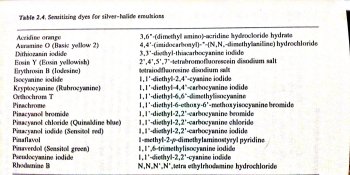wildbillbugman
Member
Hello PE and Everybody else,
I wonder if anyone out there has had any success sensitizing an emulsion to Red. Sand's SDA3057 works very well to this purpose. But at $600/gram plus a Convenience Fee it is just cost prohibitive. A while back PE wrote of one of his connections possibly producing some dyes for Emulsion Makers. I wonder, is this still possible.
If I have no alternative, I will buy more of the SDA3057. For my work, nothing but panchromatic emulsions will do. I have been evaluating some dyes. But none do as well as "J Agrigated" SDA3057.
Believe it or not, chlorophyll, freshly extracted from spinach, shows some red sensitivity, but nothing like SDA3057.
Just Dreaming,
I wonder if anyone out there has had any success sensitizing an emulsion to Red. Sand's SDA3057 works very well to this purpose. But at $600/gram plus a Convenience Fee it is just cost prohibitive. A while back PE wrote of one of his connections possibly producing some dyes for Emulsion Makers. I wonder, is this still possible.
If I have no alternative, I will buy more of the SDA3057. For my work, nothing but panchromatic emulsions will do. I have been evaluating some dyes. But none do as well as "J Agrigated" SDA3057.
Believe it or not, chlorophyll, freshly extracted from spinach, shows some red sensitivity, but nothing like SDA3057.
Just Dreaming,











